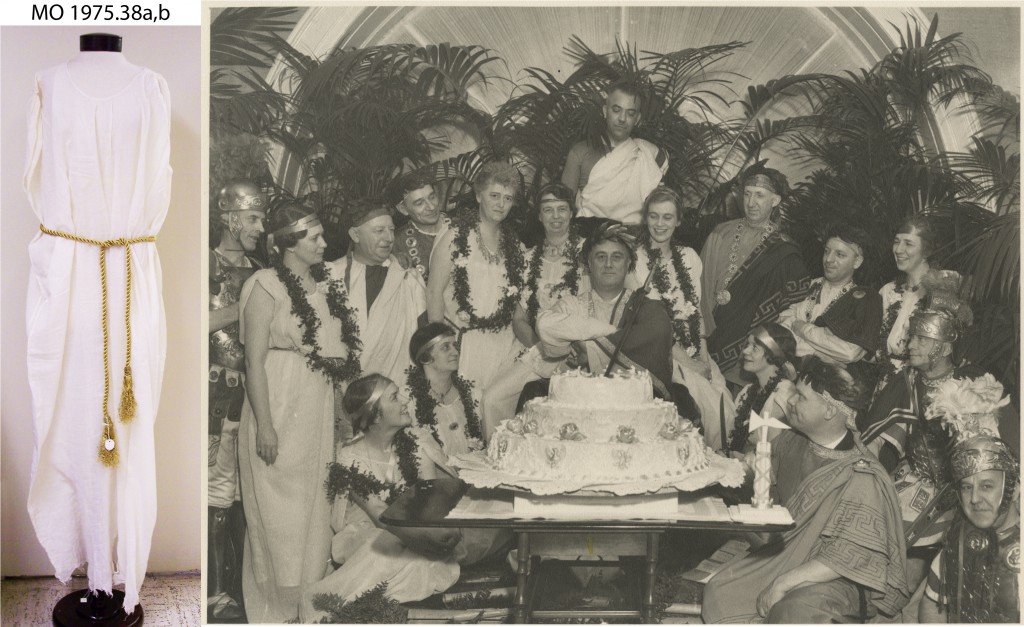 FDR presiding over one of the first known “toga parties.” (Franklin D. Roosevelt Presidential Library and Museum)
FDR presiding over one of the first known “toga parties.” (Franklin D. Roosevelt Presidential Library and Museum)
After my experiment with a Greek Symposium (where we did at one point shout “Toga! Toga! Toga!”), I got curious about the origins of the modern, pseudo-Greek, fraternal Toga Parties. And I found the photo above.
Yes. In the middle, that is indeed President Franklin D. Roosevelt. In a toga.
FDR’s critics often compared him to a dictator, going as far as to refer to him as “Caesar”. To poke fun at the name, his wife Eleanor threw him a “Dear Caesar” themed birthday on January 30th, 1934, his 52nd year of life. The costume pictured on the left is from the FDR Library & Museum and was worn by a friend of the Roosevelts to the ball. According to Henrietta Nesbitt, head of the White House housekeeping and cooking staff, the birthday cake was a fruitcake, made with dates, raisins, almonds, citron and orange peel (source).
Did Franklin and Eleanor Roosevelt throw the first toga party on record? Perhaps.
I have found one earlier reference in the novel Vile Bodies, published in 1930 (although it takes place in 1914). The book is an account of the Bright Young Things, a group of Londoners in the early 20th century perceived as “the most glamorous, influential, self-absorbed, quasi-bohemian and overeducated creatures in existence. During their flickering moment they were adored and despised in almost equal measure. (source)”
In Vile Bodies, the protagonist Adam complains ‘Oh Nina, what a lot of parties’ and the narrator elaborates:
…Masked parties, Savage parties, Victorian parties, Greek parties, Wild West parties, Russian parties, Circus parties, parties where one had to dress as somebody else, almost naked parties in St John’s wood, parties in flats and studios and houses and ships and hotels and night clubs, in windmills and swimming-baths, tea parties at school where one ate muffins and meringues and tinned crab, parties at Oxford where one drank brown sherry and smoked Turkish cigarettes, dull dances in London and comic dances in Scotland and disgusting dances in Paris – all that succession and repetition of massed humanity … Those vile bodies …
Were Greek-themed toga parties actually a thing in pre-war London? I’m uncertain.
Although the idea of a college fraternity stemmed from the Greeks, togas are Roman. So how did one become associated with the other? It’s believed to have been invented in the 1950s, but the only source is a self-referencing reference about a party at Pamona Collge in 1953. I apparently need to start doing oral histories with Pamona College alumnus (know any?). But this lineage may be entirely made-up. The toga party simple may have been a creation of popular culture.
The 1978 film Animal House had a famous Toga Party scene which over the next year, created a fervor for toga parties on college campuses. Both the Washington Post and Newsweek reported on the new phenomenon and allegedly the movie’s promoters were going campus to campus throwing toga parties. The best article I’ve found on all this comes from the Princeton Weekly newsletter, written in in the midst of the toga frenzy in 1978. A few select quotes:
Toga is wild and crazy…Toga is an excuse to let loose. Toga is bed-sheet chic and drapery decadence.
‘What do you think all this toga business means?” I asked.
“Nothing really. For a lot of people, it’s key to have a crazy time is all.”
My favorite part is when he describes a campus-sheet shortage due to over-zealous partiers and wary linen franchises. Read the whole article here.
The Official Preppy Handbook, a parody published in 1980, gives this advice: “Toga party- Girls wear designer sheets, men wear the kind from the linen service. If accompanied by a Roman-style dinner, these sheets may go home stained with red wine, though serious drinkers might switch to a grain alcohol punch around 10 o’clock. Since dancing in a toga is impossible, getting drunk is the primary activity.” In just two years, toga parties went from the height of college fashion to passé enough to be parodied.
There are a lot of gaping holes in the story of the toga party. The frustrating part about researching the history of alcohol is that apparently people were too drunk to remember.
